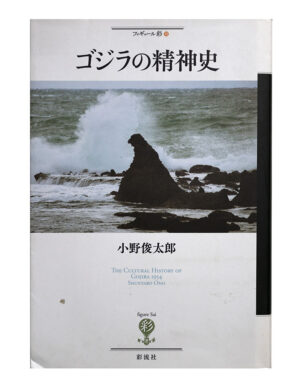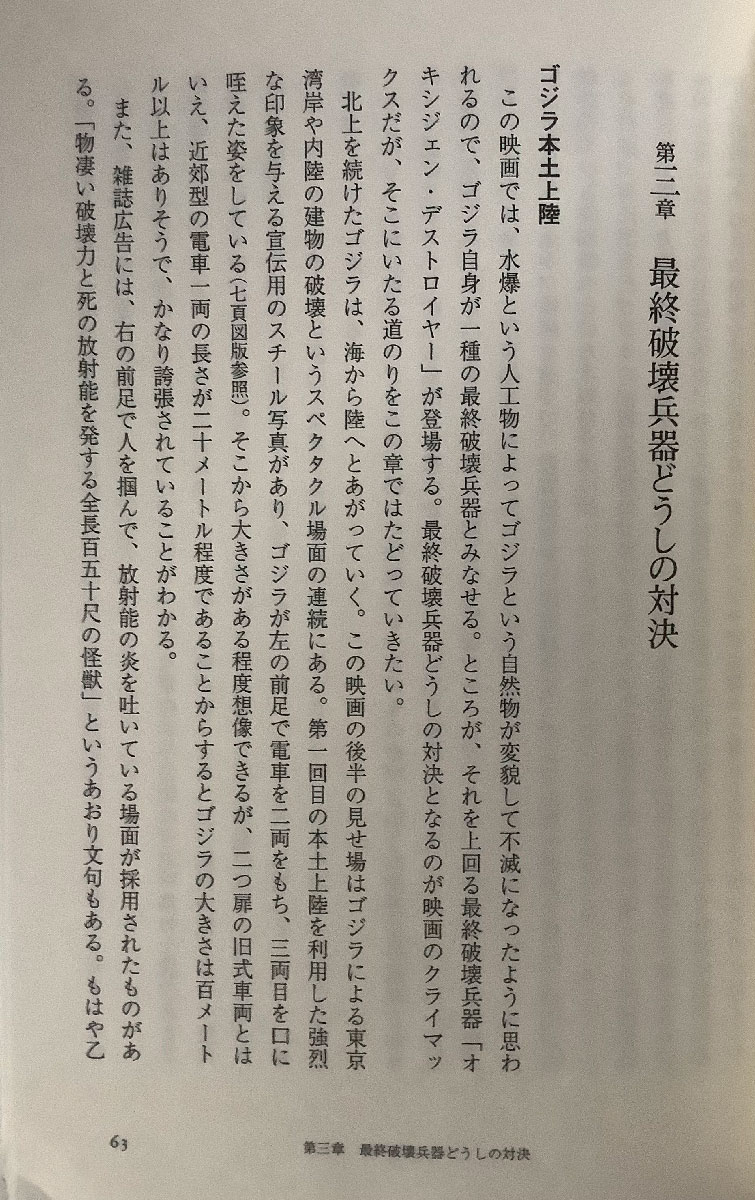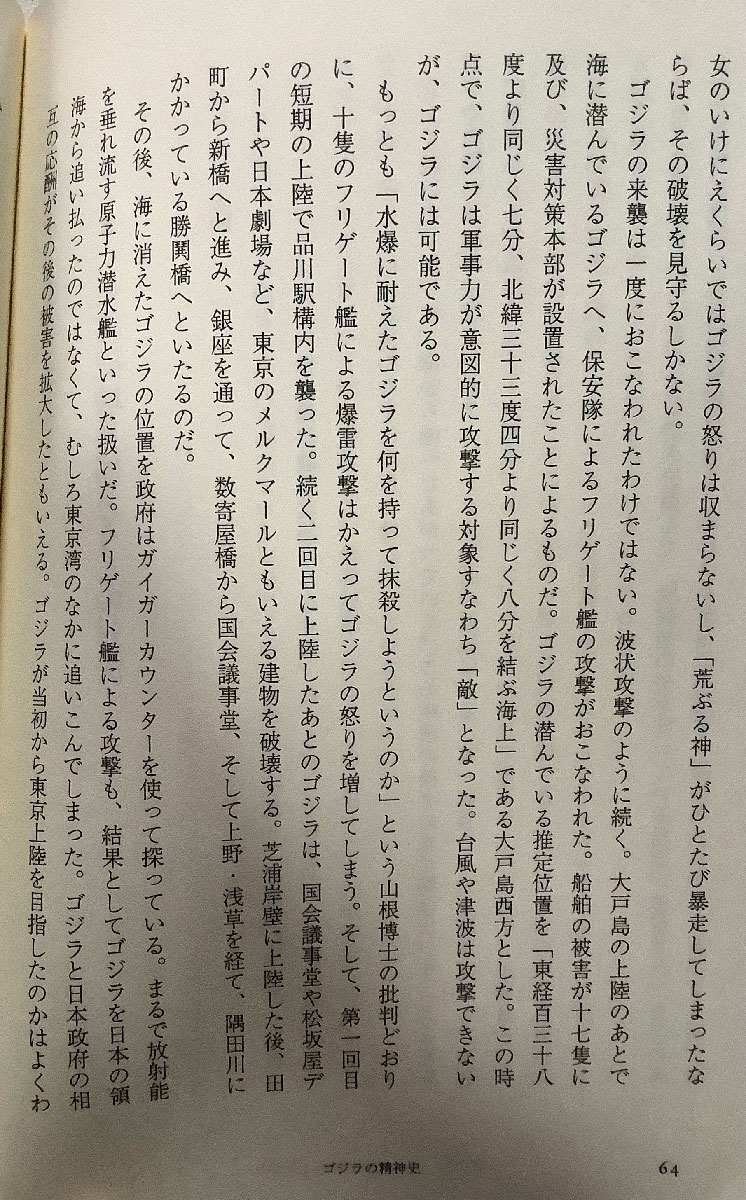1.15.2023
The Cultural History of Godzilla – Pt 26


P 63
第三章最終破壊兵器どうしの対決
Chapter 3 Confrontation between final weapons of destruction
ゴジラ本土上陸
Godzilla landed on mainland
この映画では、水爆という人工物によってゴジラという自然物が変貌して不滅になったように思われるので、ゴジラ自身が一種の最終破壊兵器とみなせる。ところが、それを上回る最終破壊兵器「オキシジェン・デストロイヤー」が登場する。最終破壊兵器どうしの対決となるのが映画のクライマックスだが、そこにいたる道のりをこの章ではたどっていきたい。
In this movie, it seems that Godzilla, a natural creature, has been transformed and immortalized by an artificial thing called a hydrogen bomb, so Godzilla himself can be regarded as a kind of ultimate destructive weapon. However, the ultimate destructive weapon “Oxygen Destroyer” that surpasses it appears. The climax of the movie is the confrontation between the weapons of ultimate destruction, and in this chapter, I would like to trace the path leading up to it.
第三章最終破壊兵器どうしの対決
Chapter 3 Confrontation between final weapons of destruction
北上を続けたゴジラは、海から陸へとあがっていく。この映画の後半の見せ場はゴジラによる東京湾岸や内陸の建物の破壊というスペクタクル場面の連続にある。第一回目の本土上陸を利用した強烈な印象を与える宣伝用のスチール写真があり、ゴジラが左の前足で電車を二両をもち、三両目を口に咥えた姿をしている(七頁図版参照)。そこから大きさがある程度想像できるが、二つ扉の旧式車両とはいえ、近郊型の電車一両の長さが二十メートル程度であることからするとゴジラの大きさは百メートル以上はありそうで、かなり誇張されていることがわかる。
Godzilla, which continued northward, rises from the sea to the land. The highlight of the second half of this movie is a series of spectacle scenes in which Godzilla destroys buildings on the coast of Tokyo Bay and inland areas. There is a striking promotional still photograph that uses the first landing on the mainland, showing Godzilla holding two train cars in his left front leg and holding the third car in his mouth ( See the illustration on page 7). From that, you can imagine the size to some extent, but even though it is an old-fashioned train with two doors, considering the length of a suburban train car is about 20 meters, it seems that Godzilla is over 100 meters in size. And it turns out to be a lot of exaggeration.
また、雑誌広告には、右の前足で人を掴んで、放射能の炎を吐いている場面が採用されたものがある。「物凄い破壊力と死の放射能を発する全長百五十尺の怪獣」というあおり文句もある。もはや乙女のいけにえくらいではゴジラの怒りは収まらないし、「荒ぶる神」がひとたび暴走してしまったならば、その破壊を見守るしかない。
In addition, some magazine advertisements have adopted a scene where he grabs a person with his right front leg and breathes out radioactive flames. There is also a catchphrase, “A 150 shaku monster that emits tremendous destructive power and deadly radiation.” Godzilla’s anger can no longer be quelled by sacrificing a maiden, and once the “savage god” goes out of control, there is no choice but to watch over its destruction.
Shaku is unit of distance approximately equal to 30.3 cm

P 64
ゴジラの来襲は一度におこなわれたわけではない。波状攻撃のように続く。大戸島の上陸のあとで海に潜んでいるゴジラへ、保安隊によるフリゲート艦の攻撃がおこなわれた。船舶の被害が十七隻に及び、災害対策本部が設置されたことによるものだ。ゴジラの潜んでいる推定位置を「東経百三十八度より同じく七分、北緯三十三度四分より同じく八分を結ぶ海上」である大戸島西方とした。この時点で、ゴジラは軍事力が意図的に攻撃する対象すなわち「敵」となった。台風や津波は攻撃できないが、ゴジラには可能である。
Godzilla’s attack didn’t happen all at once. Continues like a wave attack. After landing on Odo Island, a frigate was attacked by the Security Forces toward Godzilla hiding in the sea. Seventeen ships were damaged, and a disaster countermeasures headquarters was set up. The estimated location where Godzilla is hiding is west of Odo Island, which is “the sea connecting 7 minutes from 138 degrees east longitude and 8 minutes from 33 degrees 4 minutes north latitude.” At this point, Godzilla became a target, or “enemy,” for military forces to deliberately attack. Typhoons and tsunamis cannot attack, but Godzilla can.
もっとも「水爆に耐えたゴジラを何を持って抹殺しようというのか」という山根博士の批判どおりに、十隻のフリゲート艦による爆雷攻撃はかえってゴジラの怒りを増してしまう。そして、第一回目の短期の上陸で品川駅構内を襲った。続く二回目に上陸したあとのゴジラは、国会議事堂や松坂屋デパートや日本劇場など、東京のメルクマールともいえる建物を破壊する。芝浦岸壁に上陸した後、田町から新橋へと進み、銀座を通って、数寄屋橋から国会議事堂、そして上野・浅草を経て、隅田川にかかっている勝鬨橋へといたるのだ。
However, according to Dr. Yamane’s criticism, “What are you going to use to kill Godzilla, who has withstood the hydrogen bomb?” Then, the first short-term landing attacked the Shinagawa station premises. Godzilla after landing for the second time destroys buildings that can be called Merkmal in Tokyo, such as the National Diet Building, Matsuzakaya Department Store, and Japanese Theater. After landing at the Shibaura quay, proceed from Tamachi to Shimbashi, through Ginza, from Sukiyabashi to the National Diet Building, and then to Ueno and Asakusa to Kachidokibashi, which spans the Sumida River.
その後、海に消えたゴジラの位置を政府はガイガーカウンターを使って探っている。まるで放射能を垂れ流す原子力潜水艦といった扱いだ。フリゲート艦による攻撃も、結果としてゴジラを日本の領海から追い払ったのではなくて、むしろ東京湾のなかに追いこんでしまった。ゴジラと日本政府の相互の応酬がその後の被害を拡大したともいえる。ゴジラが当初から東京上陸を目指したのかはよくわからないのだが、火に油を注ぐ行為となった。
Since then, the government has been searching for the location of Godzilla, which disappeared into the sea, using a Geiger counter. It’s like a nuclear submarine dripping radiation. Attacks by frigates also resulted in Godzilla being forced into Tokyo Bay rather than driven out of Japanese waters. It can be said that the mutual exchange between Godzilla and the Japanese government expanded the subsequent damage. I don’t know if Godzilla was aiming to land in Tokyo from the beginning, but it became an act of pouring oil on the fire.

P 65
襲ってくるゴジラは防衛隊にとって「仮想敵国」の軍隊ではないので、映画という虚構の上でならば存分に攻撃できる。各国からゴジラ調査団も来たはずだが、どこにも外国人が活躍する様子はない。よく言われるように在日アメリカ軍の影がかき消されているのだ。現実世界の出来事なら、横須賀の第七艦隊や、横田基地の在日米軍司令部が黙って見過ごすはずがない。緊急発進がかけられるだろう。
The attacking Godzilla is not a “virtual enemy country” army for the defense force, so it can attack as much as it likes on the fiction of the movie. Godzilla investigation teams should have come from various countries, but there is no sign of foreigners being active anywhere. As is often said, the shadow of the US military in Japan has been erased. If it were a real-world event, the 7th Fleet in Yokosuka and the headquarters of the U.S. Forces in Japan at Yokota Air Base would not have let it go unnoticed. A scramble will be issued.
そうしたアメリカの不在とともに、日本の軍隊が単独で戦っているのは、空襲などの敗戦の記憶の再現だけではなくて、太平洋戦争を敗戦と受け止められずに虚構の中で継続しているのだ、という佐藤健志の指摘は説得力をもつ。しかも、ゴジラの発見と戦いが八月十三日以降に設定されているのも、八月十五日を過ぎた「幻の本土決戦」をおこなっているのだ、と佐藤は結論づけている(『ゴジラとヤマトとぼくらの民主主義』)。そのときゴジラが表現するのはアメリカ軍をはじめとする連合軍というわけだ。
In the absence of the United States, the fact that the Japanese army is fighting alone is not just a replay of the memory of its defeat, such as the air raids, but the fact that the Pacific War is not perceived as a defeat and continues in a fictional way. Takeshi Sato’s point is persuasive. Moreover, Sato concludes that the fact that Godzilla’s discovery and battle is set after August 13th is also a “phantom battle on the mainland” that has passed after August 15th (“Godzilla and Yamato and Our Democracy”). At that time, what Godzilla represents is the Allied Forces, including the United States Army.